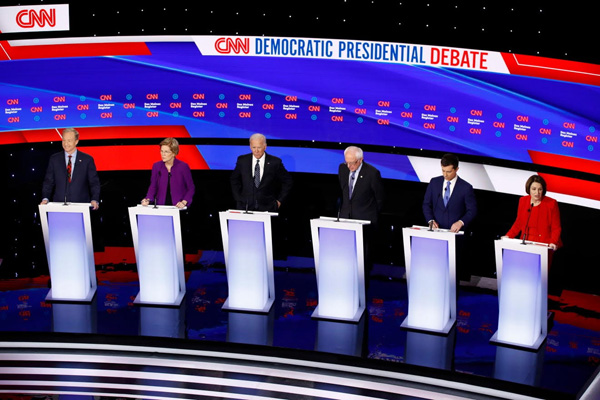
For over a year, we've perused the robust field of Democratic presidential candidates, squeezing them like melons in the produce aisle. We've wondered whether some are too old or too young. We've speculated about whether the nation is ready for a female president or, perhaps, a gay one. We've analyzed who would fare best in a debate against Typhoon Trump.
None of this will really matter until Democrats resolve the overarching issue dividing the party. With the Iowa caucuses kicking off the primary season Monday, Democrats must settle on a winning approach to governing.
The issue was drawn into sharp focus recently when the editorial board at The New York Times, despite "more than a dozen hours" questioning the leading Democrats, became paralyzed — not over candidates but over the direction the party should take. The paper broke with its 160-year tradition and gave dual endorsements. to Sens Elizabeth Warren of Massachusetts and Amy Klobuchar of Minnesota.
What stumped the Times was what it identified as a choice as between "the radical and the realist models." You might think of these positions as "ultra-progressive and center-left," and you might view them as "lanes" rather than "models." Semantics aside, the two wings of the party — which have always been part of modern Democratic posturing — are in a fierce struggle.
Do Democrats want to fix the mess created in President Donald Trump's first term, or blow it up? That's what this primary is really about.
Polling leaders among fixers are former Vice President Joe Biden, former South Bend, Indiana Mayor Pete Buttigieg and Klobuchar, who just Wednesday broke into double digits in Iowa. The duo most in favor of blowing things up are Sens. Bernie Sanders of Vermont and Elizabeth Warren.
The time for picking a lane is at hand. Much as I admire the ultra-progressive agenda, I favor staying closer to the center in this election.
As I see it, the far left represents 90% of what I favor, has a 50% chance of beating Trump and, if elected, can get 40% of what I support through Congress. The center-left represents only 75% of what I favor but has a 60% chance of beating Trump, and it, too has the very same 40% chance in Congress. Bottom line: We wind up in the same place legislatively, but the centrist Democrats have a better chance of winning in November.
In presidential elections, candidates in both parties tend to sketch out somewhat extreme positions during the primaries, and then, out of necessity, move closer to the center for the general election. The problem facing the Warren/Sanders wing this year is that rigidity is part of the appeal — and that approach is reflected among many supporters.
That makes it harder and more time-consuming to temper positions that could be damaging in the general election. And the longer the party takes to establish its governing strategy, the greater the risk that Democrats will not rally enthusiastically around the eventual nominee. We saw that in 2016 when some Sanders supporters remained cool to Hillary Clinton.
It's said that government is so broken that blowing things up is the only option. But if victory in November requires appealing to moderates, some of whom might have voted Republican in 2016, then the sledgehammer approach could be too much. Also, the ultra-progressives make an easy target for Trump. All he has to do is say "socialist" a dozen times at each campaign rally and he triggers fear — even if unreasonably — among voters who might otherwise abandon him.
Klobuchar and Buttigieg are making the most compelling cases for a center-left approach. Warren, who has an early polling advantage against both of them, who has already softened her approach to dismantling the health care system, could be the Democrats' top choice if she continues to moderate her positions. She must assure primary voters that her long-term goals do not warrant short-term fears.
The Democrats' best bet will be the candidate who favors progressive policies while acknowledging that in this election the HOV (High Occupancy Voter) lane runs down the center, not the far left.
(c) Peter Funt. This column originally appeared in USA Today.
|



